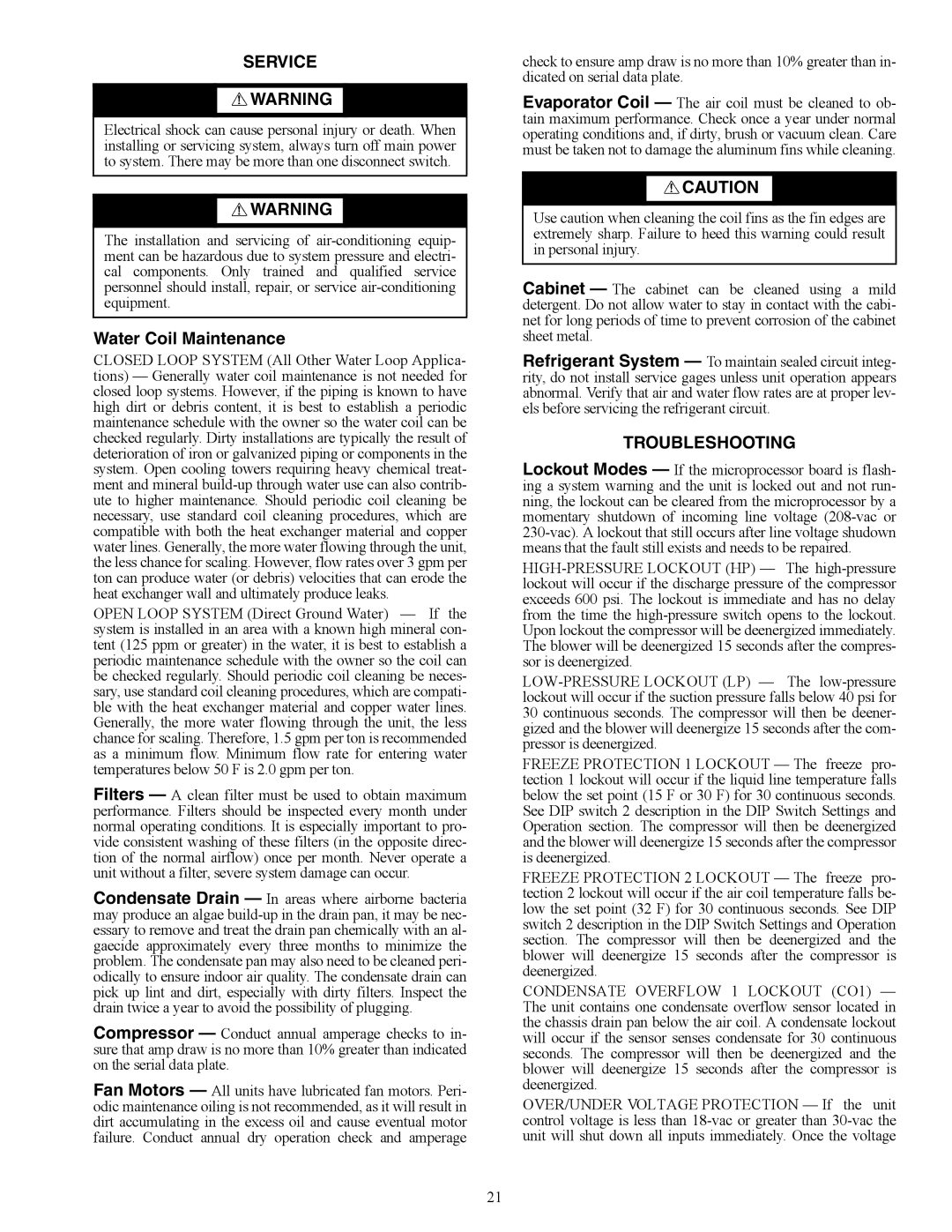
SERVICE
![]() WARNING
WARNING
Electrical shock can cause personal injury or death. When installing or servicing system, always turn off main power to system. There may be more than one disconnect switch.
![]() WARNING
WARNING
The installation and servicing of
Water Coil Maintenance
CLOSED LOOP SYSTEM (All Other Water Loop Applica- tions) — Generally water coil maintenance is not needed for closed loop systems. However, if the piping is known to have high dirt or debris content, it is best to establish a periodic maintenance schedule with the owner so the water coil can be checked regularly. Dirty installations are typically the result of deterioration of iron or galvanized piping or components in the system. Open cooling towers requiring heavy chemical treat- ment and mineral
OPEN LOOP SYSTEM (Direct Ground Water) — If the system is installed in an area with a known high mineral con- tent (125 ppm or greater) in the water, it is best to establish a periodic maintenance schedule with the owner so the coil can be checked regularly. Should periodic coil cleaning be neces- sary, use standard coil cleaning procedures, which are compati- ble with the heat exchanger material and copper water lines. Generally, the more water flowing through the unit, the less chance for scaling. Therefore, 1.5 gpm per ton is recommended as a minimum flow. Minimum flow rate for entering water temperatures below 50 F is 2.0 gpm per ton.
Filters — A clean filter must be used to obtain maximum performance. Filters should be inspected every month under normal operating conditions. It is especially important to pro- vide consistent washing of these filters (in the opposite direc- tion of the normal airflow) once per month. Never operate a unit without a filter, severe system damage can occur.
Condensate Drain — In areas where airborne bacteria may produce an algae
Compressor — Conduct annual amperage checks to in- sure that amp draw is no more than 10% greater than indicated on the serial data plate.
Fan Motors — All units have lubricated fan motors. Peri- odic maintenance oiling is not recommended, as it will result in dirt accumulating in the excess oil and cause eventual motor failure. Conduct annual dry operation check and amperage
check to ensure amp draw is no more than 10% greater than in- dicated on serial data plate.
Evaporator Coil — The air coil must be cleaned to ob- tain maximum performance. Check once a year under normal operating conditions and, if dirty, brush or vacuum clean. Care must be taken not to damage the aluminum fins while cleaning.
![]() CAUTION
CAUTION
Use caution when cleaning the coil fins as the fin edges are extremely sharp. Failure to heed this warning could result in personal injury.
Cabinet — The cabinet can be cleaned using a mild detergent. Do not allow water to stay in contact with the cabi- net for long periods of time to prevent corrosion of the cabinet sheet metal.
Refrigerant System — To maintain sealed circuit integ- rity, do not install service gages unless unit operation appears abnormal. Verify that air and water flow rates are at proper lev- els before servicing the refrigerant circuit.
TROUBLESHOOTING
Lockout Modes — If the microprocessor board is flash- ing a system warning and the unit is locked out and not run- ning, the lockout can be cleared from the microprocessor by a momentary shutdown of incoming line voltage
FREEZE PROTECTION 1 LOCKOUT — The freeze pro- tection 1 lockout will occur if the liquid line temperature falls below the set point (15 F or 30 F) for 30 continuous seconds. See DIP switch 2 description in the DIP Switch Settings and Operation section. The compressor will then be deenergized and the blower will deenergize 15 seconds after the compressor is deenergized.
FREEZE PROTECTION 2 LOCKOUT — The freeze pro- tection 2 lockout will occur if the air coil temperature falls be- low the set point (32 F) for 30 continuous seconds. See DIP switch 2 description in the DIP Switch Settings and Operation section. The compressor will then be deenergized and the blower will deenergize 15 seconds after the compressor is deenergized.
CONDENSATE OVERFLOW 1 LOCKOUT (CO1) — The unit contains one condensate overflow sensor located in the chassis drain pan below the air coil. A condensate lockout will occur if the sensor senses condensate for 30 continuous seconds. The compressor will then be deenergized and the blower will deenergize 15 seconds after the compressor is deenergized.
OVER/UNDER VOLTAGE PROTECTION — If the unit control voltage is less than
21
